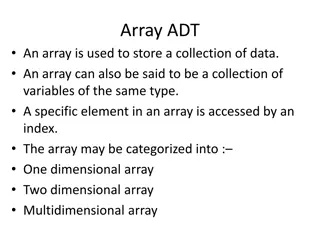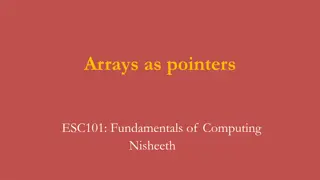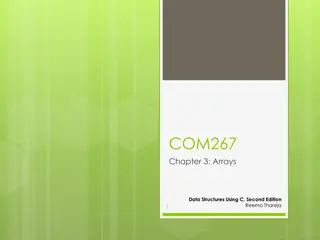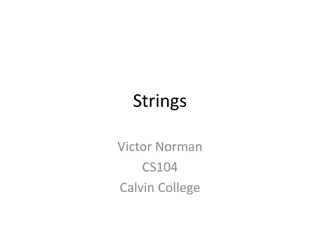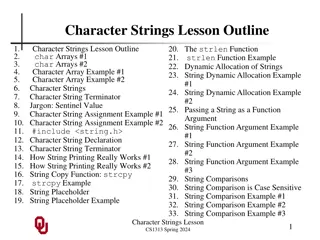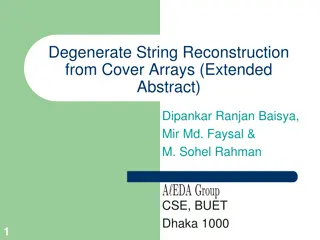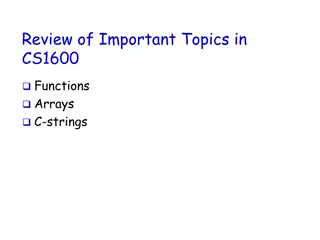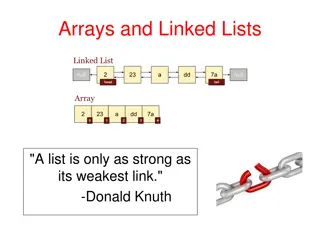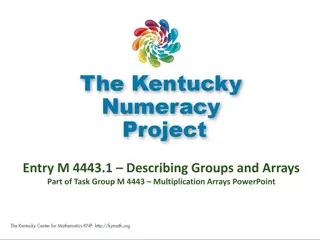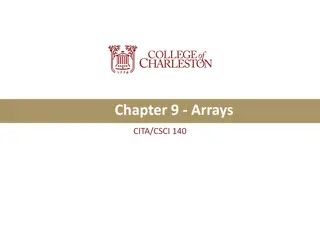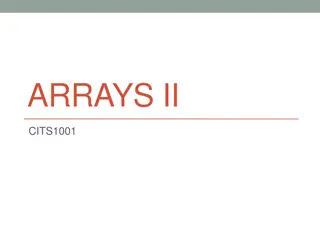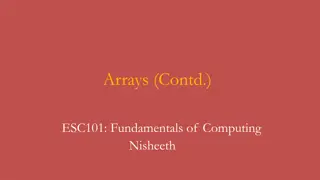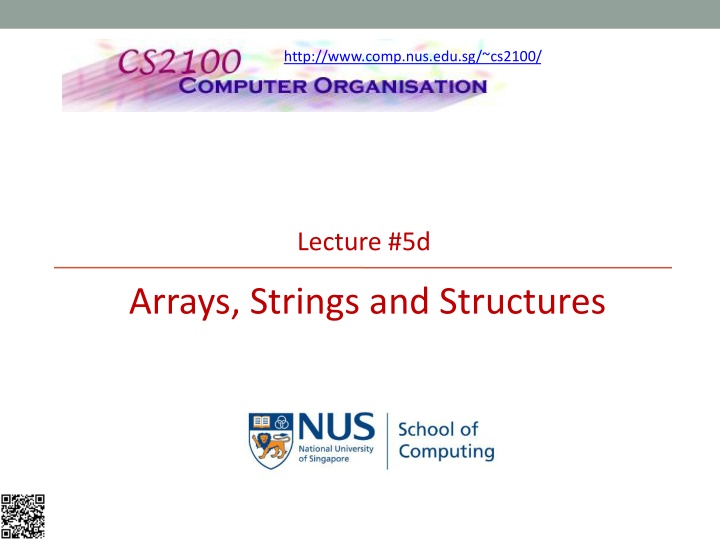
Arrays, Strings, and Structures in CS2100 Lecture #5
Dive into the concepts of arrays, strings, and structures as discussed by Aaron Tan in NUS Lecture #5. Explore passing structures to functions, array of structures, and passing the address of structures to functions. Learn how to organize and manipulate data effectively with these fundamental programming constructs.
Download Presentation

Please find below an Image/Link to download the presentation.
The content on the website is provided AS IS for your information and personal use only. It may not be sold, licensed, or shared on other websites without obtaining consent from the author. If you encounter any issues during the download, it is possible that the publisher has removed the file from their server.
You are allowed to download the files provided on this website for personal or commercial use, subject to the condition that they are used lawfully. All files are the property of their respective owners.
The content on the website is provided AS IS for your information and personal use only. It may not be sold, licensed, or shared on other websites without obtaining consent from the author.
E N D
Presentation Transcript
http://www.comp.nus.edu.sg/~cs2100/ Lecture #5d Arrays, Strings and Structures
Questions? IMPORTANT: DO NOT SCAN THE QR CODE IN THE VIDEO RECORDINGS. THEY NO LONGER WORK Ask at https://sets.netlify.app/module/676ca3a07d7f5ffc1741dc65 OR Scan and ask your questions here! (May be obscured in some slides)
Aaron Tan, NUS Lecture #5: Arrays, Strings and Structures 3 4.9 Passing Structure to Function (1/2) Passing a structure to a parameter in a function is akin to assigning the structure to the parameter. The entire structure is copied, i.e., members of the actual parameter are copied into the corresponding members of the formal parameter. Pass-by-value We use PassStructureToFn.c to illustrate this.
Aaron Tan, NUS Lecture #5: Arrays, Strings and Structures 4 player1: name = Brusco; age = 23; gender = M player2: name = July; age = 21; gender = F 4.9 Passing Structure to Function (2/2) PassStructureToFn.c // #include statements and definition // of player_t are omitted here for brevity void print_player(char [], player_t); int main(void) { player_t player1 = { "Brusco", 23, 'M' }, player2; strcpy(player2.name, "July"); player2.age = 21; player2.gender = 'F'; Passing a structure to a function print_player("player1", player1); print_player("player2", player2); } return 0; Receiving a structure from the caller // Print player s information void print_player(char header[], player_t player) { printf("%s: name = %s; age = %d; gender = %c\n", header, player.name, player.age, player.gender); }
Aaron Tan, NUS Lecture #5: Arrays, Strings and Structures 5 (For own reading) 4.10 Array of Structures Combining structures and arrays gives us a lot of flexibility in organizing data. For example, we may have a structure comprising 2 members: student s name and an array of 5 test scores he obtained. Or, we may have an array whose elements are structures. Or, even more complex combinations such as an array whose elements are structures which comprises array as one of the members. Case study (Program: NearbyStores.c) A startup company decides to provide location-based services. Its customers are a list of stores. Each store has a name, a location given by (x, y) coordinates, a radius that defines a circle of influence. We can define a structure type store_t for the stores, and have a store_t array store_t variables. We call this array storeList and it represents the list of stores.
Aaron Tan, NUS Lecture #5: Arrays, Strings and Structures 6 4.11 Passing Address of Structure to Function (1/5) Given this code, what is the output? PassStructureToFn2.c // #include statements, definition of player_t, // and function prototypes are omitted here for brevity int main(void) { player_t player1 = { "Brusco", 23, 'M' }; } change_name_and_age(player1); print_player("player1", player1); return 0; player1: name = Brusco; age = 23; gender = M // To change a player s name and age void change_name_and_age(player_t player) { strcpy(player.name, "Alexandra"); player.age = 25; } // Print player s information void print_player(char header[], player_t player) { printf("%s: name = %s; age = %d; gender = %c\n", header, player.name, player.age, player.gender); }
Aaron Tan, NUS Lecture #5: Arrays, Strings and Structures 7 4.11 Passing Address of Structure to Function (2/5) player1 main() name age gender "Brusco" 'M' 23 change_name_and_age(player1); change_name_and_age(player_t player) player name age gender 23 25 'M' "Brusco" "Alexandra" strcpy(player.name, "Alexandra"); player.age = 25;
Aaron Tan, NUS Lecture #5: Arrays, Strings and Structures 8 4.11 Passing Address of Structure to Function (3/5) Like an ordinary variable (eg: of type int, char), when a structure variable is passed to a function, a separate copy of it is made in the called function. Hence, the original structure variable will not be modified by the function. To allow the function to modify the content of the original structure variable, you need to pass in the address (pointer) of the structure variable to the function. (Note that passing an array of structures to a function is a different matter. As the array name is a pointer, the function is able to modify the array elements.)
Aaron Tan, NUS Lecture #5: Arrays, Strings and Structures 9 4.11 Passing Address of Structure to Function (4/5) Need to pass address of the structure variable PassAddrStructToFn.c // #include statements, definition of player_t, // and function prototypes are omitted here for brevity int main(void) { player_t player1 = { "Brusco", 23, 'M' }; } change_name_and_age(&player1); print_player("player1", player1); return 0; player1: name = Alexandra; age = 25; gender = M // To change a player s name and age void change_name_and_age(player_t *player_ptr) { strcpy((*player_ptr).name, "Alexandra"); (*player_ptr).age = 25; } // Print player s information void print_player(char header[], player_t player) { printf("%s: name = %s; age = %d; gender = %c\n", header, player.name, player.age, player.gender); }
Aaron Tan, NUS Lecture #5: Arrays, Strings and Structures 10 4.11 Passing Address of Structure to Function (5/5) player1 main() name age gender "Brusco" "Alexandra" 23 25 'M' change_name_and_age(&player1); change_name_and_age(player_t *player_ptr) player_ptr strcpy((*player_ptr).name, "Alexandra"); (*player_ptr).age = 25;
Aaron Tan, NUS Lecture #5: Arrays, Strings and Structures 11 4.12 The Arrow Operator (->) (1/2) Expressions like (*player_ptr).name appear very often. Hence an alternative shortcut syntax is created for it. The arrow operator (->) (*player_ptr).name player_ptr->name is equivalent to (*player_ptr).age player_ptr->age is equivalent to Can we write *player_ptr.name instead of (*player_ptr).name? No, because . (dot) has higher precedence than *, so *player_ptr.name means *(player_ptr.name)!
Aaron Tan, NUS Lecture #5: Arrays, Strings and Structures 12 4.12 The Arrow Operator (->) (2/2) Function change_name_and_age() in PassAddrStructToFn2.c modified to use the -> operator. PassAddrStructToFn2.c // To change a player s name and age void change_name_and_age(player_t *player_ptr) { strcpy(player_ptr->name, "Alexandra"); player_ptr->age = 25; }
Aaron Tan, NUS Lecture #4: Pointers and Functions 13 Quiz Please Arrays, Strings and Structures Quiz 1 before 3 pm on 23 August 2022.
Aaron Tan, NUS Lecture #5: Arrays, Strings and Structures 14 End of File

